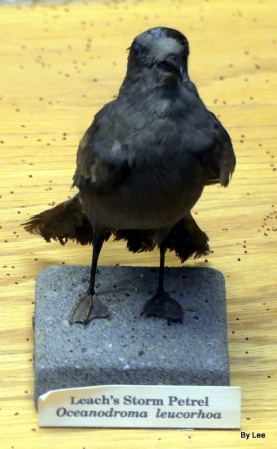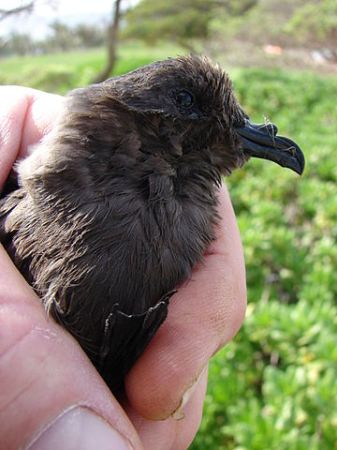As promised, in Waterman Bird Collection – Part II, here are the last two birds from that display. The Leach’s Storm Petrel and the Crow will now be introduced. Many of you already have heard of a Crow, but how about a Storm Petrel? Let’s see what we can find out about these avian creations from the Creator.
The two birds today are the two right hand birds in the Display.
The Leach’s Storm Petrel [at the top] is starting to show a tiny bit of deterioration, but considering it’s over 100 years old, it’s not too much.
“The Leach’s Storm Petrel or Leach’s Petrel (Oceanodroma leucorhoa) is a small seabird of the tubenose order. It is named after the British zoologist William Elford Leach. The scientific name is derived from Ancient Greek. Oceanodroma is from okeanos, “ocean” and dromos, “runner”, and leucorhoa is from leukos, “white” and orrhos, “rump”.
“It breeds on inaccessible islands in the colder northern areas of the Atlantic and Pacific. It nests in colonies close to the sea in well concealed areas such as rock crevices, shallow burrows or even logs. It lays a single white egg which often has a faint ring of spots at the large end. This storm petrel is strictly nocturnal at the breeding sites to avoid predation by gulls and skuas, and will even avoid coming to land on clear moonlit nights. The largest colony of Leach’s storm petrels can be found on Baccalieu Island of eastern Canada, an ecological reserve with more than 3 million pairs of the bird.” [Wikipedia with editing]
Fun Fact: “Flies swiftly, erratically, buoyantly with 1 or 2 fast, powerful flaps followed by glides on wings held well above the horizontal and noticeably kinked; sudden changes of direction impart a bounding quality. Flutters less than other storm-petrels.” [Neotropical Birds]
Drinks salt water – Formed By Him – Sea Birds That Drink Seawater, is an interesting article about Tubenose birds.
The last bird in the part of the collection is a Crow. It wasn’t shown which one exactly, so we are using the American Crow.
“The American crow (Corvus brachyrhynchos) is a large passerine bird species of the family Corvidae. It is a common bird found throughout much of North America. American crows are the new world counterpart to the carrion crow and the hooded crow. Although the American crow and the hooded crow are very similar in size, structure and behavior, their calls are different. The American crow nevertheless occupies the same role the hooded crow does in Eurasia.”
“From beak to tail, an American crow measures 40–50 cm (16–20 in), almost half of which is tail. Mass varies from about 300 to 600 g (11 to 21 oz). Males tend to be larger than females. The most usual call is CaaW!-CaaW!-CaaW!.’
“The American crow is all black, with iridescent feathers. It looks much like other all-black corvids. They can be distinguished from the common raven (C. corax) because American crows are smaller and from the fish crow (C. ossifragus) because American crows do not hunch and fluff their throat feathers when they call, and from the carrion crow (C. corone) by the enunciation of their calls.” [American Crow – Wikipedia]
A Cool Fact from American Crows – All About Birds:
- Crows sometimes make and use tools. Examples include a captive crow using a cup to carry water over to a bowl of dry mash; shaping a piece of wood and then sticking it into a hole in a fence post in search of food; and breaking off pieces of pine cone to drop on tree climbers near a nest.
*
Here are the links to this Series:
Waterman Bird Collection – Part I.
Waterman Bird Collection – Part II







